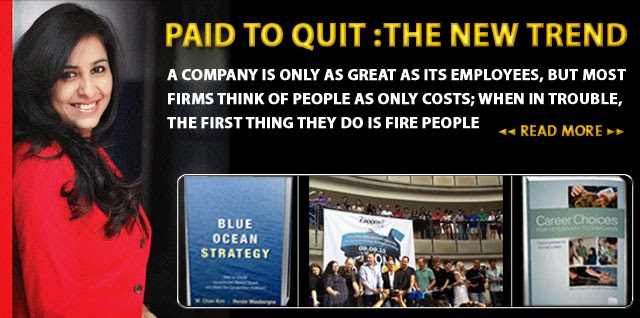PAID TO QUIT : THE NEW TREND
Jeff Bezos has done it. Zappos has been doing it for a long time now, and soon, many more companies would follow suit. The new trend catching up is of companies paying their employees to quit!
Yes, it’s no more the era of receiving incentives just for living up to the target; today, one may even get an incentive for not living up to the target or expectations!
THE PROBLEM: You need to have the right skills and the right attitude
The secret to a successful organization is the spirit of the workplace. If there is positivity and enthusiasm, then everybody is motivated and works to the best of their potential. But there are just a handful of organizations that can boast of such a work environment. According to a study done by Gallup in 2013 (State of the American Workplace report), only 30% of the employees are committed to working sincerely. There are 20% people in most places who are actually counterproductive and bring about negativity and discontent among their coworkers. The rest 50% just put in their time, and their contributions are hardly significant. The group to worry about are the 20% counterproductive employees. They cost the company a lot. These unproductive employees, apart from negatively influencing fellow workers, also have high absenteeism rates. They invariably provide poor service, which drives away a lot of potential customers. All this in the long run culminates into a huge loss for an organization.
If we go by the Gallop survey, then these unproductive employees cost the US economy around half a trillion dollars every year, which is a huge waste. The same would be true in every other business environment. So it becomes extremely important to weed out from your organization these kind of employees as soon as possible. A creative way of doing it is to follow Zappos and Amazon.
Yes, it’s no more the era of receiving incentives just for living up to the target; today, one may even get an incentive for not living up to the target or expectations!
THE PROBLEM: You need to have the right skills and the right attitude
The secret to a successful organization is the spirit of the workplace. If there is positivity and enthusiasm, then everybody is motivated and works to the best of their potential. But there are just a handful of organizations that can boast of such a work environment. According to a study done by Gallup in 2013 (State of the American Workplace report), only 30% of the employees are committed to working sincerely. There are 20% people in most places who are actually counterproductive and bring about negativity and discontent among their coworkers. The rest 50% just put in their time, and their contributions are hardly significant. The group to worry about are the 20% counterproductive employees. They cost the company a lot. These unproductive employees, apart from negatively influencing fellow workers, also have high absenteeism rates. They invariably provide poor service, which drives away a lot of potential customers. All this in the long run culminates into a huge loss for an organization.
If we go by the Gallop survey, then these unproductive employees cost the US economy around half a trillion dollars every year, which is a huge waste. The same would be true in every other business environment. So it becomes extremely important to weed out from your organization these kind of employees as soon as possible. A creative way of doing it is to follow Zappos and Amazon.
THE SOLUTION: Fit in to stand out!
Each company has its own unique culture. To really do well, you need to blend with that culture. You should really want to be a part of the whole system. Most importantly, you need to really love what you are doing. However, this is not the case always and a new recruit may find he is stuck in the wrong job. What does he do? Zappos seems to have found a way.
 Zappos is an online shoe and apparel vendor, which has mastered the art of customer service. As a result, productivity is at its highest here. All new recruits go through an intensive four weeks of training, where they are introduced to not just the company’s various processes but also its culture and its commitments. After these four weeks are over, the company sends an offer to all the new recruits, which goes like this: “If you quit today, we will pay you for the amount of time you’ve worked so far plus a $3,000 bonus. Cash on hand. No questions asked.”
Zappos is an online shoe and apparel vendor, which has mastered the art of customer service. As a result, productivity is at its highest here. All new recruits go through an intensive four weeks of training, where they are introduced to not just the company’s various processes but also its culture and its commitments. After these four weeks are over, the company sends an offer to all the new recruits, which goes like this: “If you quit today, we will pay you for the amount of time you’ve worked so far plus a $3,000 bonus. Cash on hand. No questions asked.”Why would they do that?
So that they are absolutely sure that the people they are going to invest in, in the future are really committed. And on their part, the new recruits are sure that this is what they want to do. This actually saves huge costs in the long run. A wrong person in the wrong job can make both the company and the employee miserable.
Not many companies can do the same and offer such lucrative cash rewards, but a lesson to be learnt here is that recruitment is a very difficult process and the company should be very, very sure of the kind of people that are getting on to its bus, for the wrong people can derail your plans irrevocably. A resume, an interview, are not enough to judge the potential of a new hire. A few weeks into the job gives one a better idea about the candidate. Weed out the wrong hires and keep the best ones only. Zappos and Amazon do this by offering cash incentives, which makes the process more amicable.
Not just does Amazon ensure that the wrong new recruits are off the bus and hit the road within four weeks of being hired, but it also has a lovely plan for its employees who have put in three years or more into the company. The initiative, named ‘Career Choice’ (started in 2012), gives $2,000 per annum in reimbursement to any employee who wants to do a vocational course to improve his skills. They could choose courses as varied as dental hygiene and nursing, aircraft mechanics, computer aided design etcetera. Although the course chosen by an employee may have nothing to do with the work he is doing at Amazon, the company feels it would give them a chance to learn a new skill, and if required, find an alternative career and move on. All this might be a PR gimmick to cover up stories of Amazon’s workers suffering heat related injuries in its warehouses, but the fact is that you need to keep weeding off from the workplace demotivated, negative and counterproductive employees continuously to keep the productivity of the organization high. These initiatives help companies do it efficiently.
 As mentioned earlier, the final aim is that both the company and the employees need to be absolutely sure they are on the right bus; otherwise it’s a waste of time, effort, and resources for both and a sure-shot recipe for failure.
As mentioned earlier, the final aim is that both the company and the employees need to be absolutely sure they are on the right bus; otherwise it’s a waste of time, effort, and resources for both and a sure-shot recipe for failure.THE SUCCESS SECRET: All it takes is a good leader
If 20% of the employees are generally unproductive, then part of the blame goes to poor leadership. Research has shown that most of the leaders spend 20% to even 40% of their time doing unproductive activities.
As a case in point, in one organization, leaders at the top were busy managing day-to-day problems instead of focusing on and working on a long term vision. The middle level leaders were most of the time busy pleasing the leaders at the top, instead of putting in efforts to really get to know their juniors and help them channelize their energies into more productive ventures. The bottom or front level people were busy making reports or waiting for approvals from their seniors, instead of spending all their energies into serving the customers. So in effect, everyone was busy and drained out, but it all added up to zilch.
 The writers of the book ‘Blue Ocean Strategy’ applied the same concept to leadership and showed how restructuring the day of leaders and making it more productive by weeding out counterproductive actions could give your company the winning edge.
The writers of the book ‘Blue Ocean Strategy’ applied the same concept to leadership and showed how restructuring the day of leaders and making it more productive by weeding out counterproductive actions could give your company the winning edge. A company is only as great as its employees. Most organizations think of people as only costs; and when in trouble, the first thing they do is fire people to reduce costs. Others think of people as easily replaceable assets. People are not interchangeable or so easily replaceable like outdated computers or machines. They are the ones who define the company. So they cannot be treated as ‘cost centers’ or ‘easily replaceable assets’; instead, they are the family whom you need to bond with and take care of in a warm and loving environment.
If you can create that winning environment that helps nurture not just great employees but also great leaders, you would have succeeded in creating that ‘blue ocean’ where no competitor would be able to enter. You would have the most dedicated and devoted set of people; and hopefully, none would be asked to pay to quit!



Comments
Post a Comment